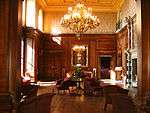Addington Palace





Addington Palace is an 18th-century mansion in Addington near Croydon in south London, England.
History
The original manor house called 'Addington Place' was built about the 16th century.
A delicious ancient recipe for Malepigernout or Dillegrout, a spiced chicken porridge, was historically made by the current Lord of the Manor of Addington to be served upon the Coronation of the Monarch of England. The Leigh family gained this serjeanty upon becoming Lords of the Manor of Addington prior to the coronation of Charles II in 1661. The Addington estate was owned by the Leigh family until the early 18th century. Sir John Leigh died without heirs in 1737 and his estates went to distant relatives, who eventually sold to Barlow Trecothick.[1]
Mr Trecothick had been brought up in Boston, Massachusetts, and became a merchant there; he then moved to London still trading as a merchant, and later became Lord Mayor and then an MP. He bought the estate for £38,500 (equivalent to £4,810,000 in 2015) and then became Lord Mayor of the City of London in 1770.
He built a new house, designed by Robert Mylne in the Palladian style; a country mansion with single-storey wings. He died before it was completed in 1774 [1] and it was inherited by his heir, James Ivers, who had to take the surname 'Trecothick' in order to inherit the estate. James continued the work on the house, having the substantial grounds and gardens landscaped by Lancelot "Capability" Brown. Due to financial difficulties, James Trecothick had to sell the estate in 1802. The estate was sold in lots in 1803.[1] The next owners (William Coles and Westgarth Snaith) [1] also got into financial trouble and sold it by Act of Parliament in 1807. This enabled the mansion to be purchased for the Archbishops of Canterbury, since nearby Croydon Palace had become inconvenient. It became 'Addington Farm' under the first few Archbishops and gradually changed to Addington Palace. It was the residence for six Archbishops of Canterbury. The archbishops made further changes and enlarged the building; work on the building was overseen by Richard Norman Shaw. It became the official second home of six archbishops:
- Charles Manners-Sutton from 1805,
- William Howley from 1828,
- John Bird Sumner from 1848,
- Charles Thomas Longley from 1862,
- Archibald Campbell Tait from 1868,
- Edward White Benson from 1883.
All except Benson are buried in St Mary's Church or churchyard, Addington; Benson is buried in Canterbury Cathedral.
The house was sold in 1897 to Mr F.A. English, a diamond merchant from South Africa. After his death, the mansion in World War I was taken over by the Red Cross and became a fever hospital, but eventually it came into the hands of the County Borough of Croydon in 1930.
Current usage
The house was Grade II* listed in 1951.[2] In 1953, it was leased to the Royal School of Church Music, initially to house choirboys assembled from all over Britain to sing at the Coronation of Queen Elizabeth II.[3] The building housed the Royal School of Church Music's music publishing operation, residential college and choir school until 1996, when a private company took it over for development as a conference and banqueting venue, health farm and country club. It is used extensively for weddings. [4]
It is surrounded by a park and golf courses, and its gardens are still largely in their original design. Much of the grounds have been leased by golf clubs and the exclusive Bishops Walk housing development was built on Bishops Walk (a private road).
A famous very large cedar tree stands next to the Palace.
See also
- Croydon Palace, the summer residence of the Archbishop of Canterbury for 500 years
External links
- Addington Palace – Surrey Wedding Venue & Conference Centre
- Addington Palace – Surrey Health Club & Spa
- Friends of Old Palace, Croydon, Surrey
References
| Wikimedia Commons has media related to Addington Palace. |
- 1 2 3 4 Malden, H.E., ed. (1912). "Parishes: Addington". A History of the County of Surrey. 4. London: Victoria County History. pp. 164–168.
- ↑ Historic England. "Addington Palace (Royal School of Church Music) (Grade II*) (1358819)". National Heritage List for England. Retrieved 7 December 2015.
- ↑ "Choristers of the Coronation". BBC Radio 4. 25 May 2013. Retrieved 8 December 2015.
- ↑ "Addington Palace". Addington Palace. Retrieved 8 December 2015.
Coordinates: 51°21′27″N 0°02′27″W / 51.35750°N 0.04083°W
